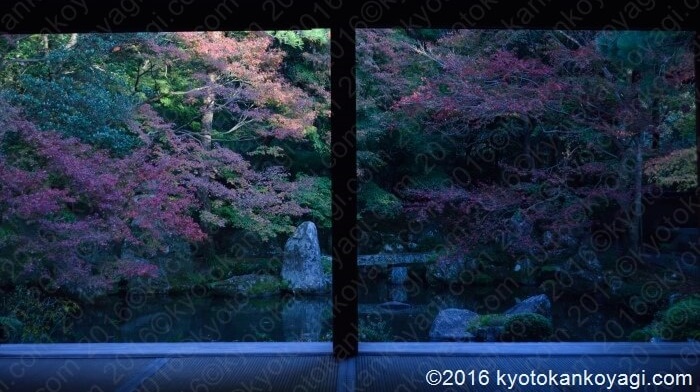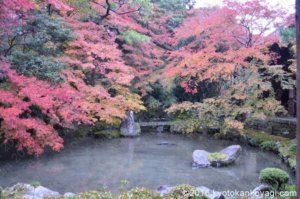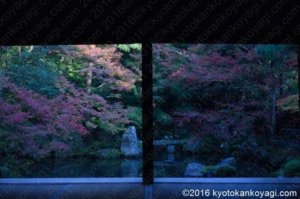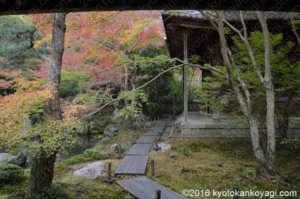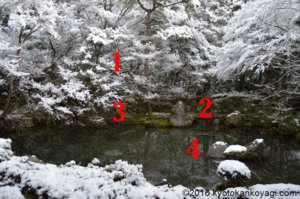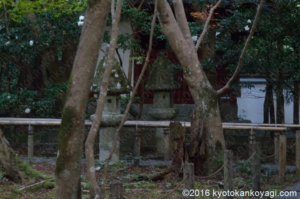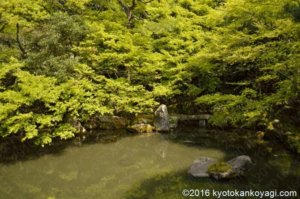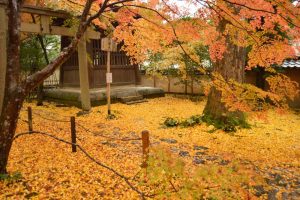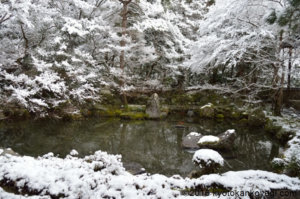Overview
- Rengeji has one of the most underrated garden to visit in Kyoto.
- It is also an overlooked place to admire autumn leaves.
- The garden stands for a paradise in Buddhism. We are allowed to take photo of the garden only in a room. I’ll show you the reason later.
- Rengeji enshrines a statue of Gautama Buddha but we cannot see it at all.
- In the main hall, there is a statue of Amidaba. It escaped the attack of Oda Nobunaga narrowly.
- There are unique stone lanterns.
- Be quiet there.
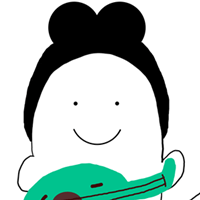
The last one is the most imporant~Promise me~
What is Rengeji temple? 蓮華寺の由来
Rengeji temple used to be a Buddhist temple of Jisyu School located in suburb area in ancient Kyoto city. In the 15th century, Ohini no Ran, the largest civil war devasteted it. In 1622, Imaeda Minbu Chikayoshi who served to wealth Kaga Han (Han is a domain in federal period), brought it to Takano region to pray for the peace of his grand father’s soul with help of famous figure: Ishikawa Jozan, the founder of Shisendo temple, and Ingen Zenshi, the founder of Obaku school of Zen Buddhisim.
The word “Renge” means lotus but the temple was named after “Rengezo.” Rengezo is a Buddhist paradise on a huge lotus.
The garden 庭園
Overview
Rengeji has an extraordinary garden. It has small pond and amazing maple trees around it. The pond takes advantage of the Takano river as an irrigation source. It is one of the most underrated garden in Kyoto. We can admire it in complete silence except fall. It is a so-called Gakubuchi Teien. Gakubuchi Teien is a technique to enjoy garden considering pillars as frame.
We can walk in the garden to the main hall.
Hourai san mountain 蓬莱山
Horai san is a mountain in ancient China. In Taoism, it is a symbol of eternal life. In the garden, Stones stand for it. (1) On the Horai san, there is a turtle with ears which has a stela on its back. It is a mixture of Kirin and turtle. Kirin is an imaginary sacred animal who rules the sky. On the contrary, turtle rules the ground. They are put together and stand for the universe.
In addtion to it, there are Kame Shima island and Tsuru Ishi stone. Kame (turtle/tortoise) and Tsuru (crane) made a sign of good fortune. They imply there is something which brings us luck and there are the universe and eternal life i.e., the garden represents Jodo, a paradise in Buddhism. In the pond, there is a stone called Funaishi. Funaishi means a boat heading for Jodo. In a nut shell, the whole garden means we are in Jodo.
We are allowed to take photo of the garden only in a room because maple trees hide the paradise. On the other hand, we can be face to face to it. In Japan, it is considered vulgar deeds to take photo of something sacred. So, it is prohibited to take photo in the garden.

NO PHOTOS in the garden!

The garden is so quiet that it is suitable for meditation!
The main hall of Rengeji 蓮華寺本堂
A statue of Gautama Buddha 釈迦如来像
In the center of the main hall, there is an old lacquered box with exquisite shell inlays. These inlays make stunning Shochikuzu (The picture of pine tree, bamboo, and Japanese plum.) and Kachozu (The picture of flower and bird). There is a statue of Gautama Buddha. To our regret, we are not able to see it for good. The box is so old that it will collapse with the statue when we open it. On the pillars in the both side of the box, there are plates. They read: “本源宗正派” and “覚苑永長春.” These sentence pray for a prosperity of Buddhist teaching.
Statue of Amidaba 阿弥陀如来像
On the left side of the box, you will find a statue of Amidaba. In 1571, Oda Nobunaga destroyed a Enryakuji temples and villages in the mount Hiei. Before his forces set a fire the temple, two monks leave there with a statue of Amidaba on their backs. They arrived a village in which Rengeji is located today and asked the villageoise to keep the staue in secret place. After Rengeji moved to the village, their descendants revealed the story and asked a monk to enshrine the statue.
Statue of Akala 不動明王像
On the right side of the box contains the statue of Gautama Buddha, there also is a box with shell inlays. You find the Kanji 寿 and 福. They both mean good fortune. Inside of it, there is a statue of Akala, the Deity who is a guardian of Buddhism.
Keyaki pillars 欅の柱
The pillars of the main hall are made of Keyaki tree. It don’t grow straight. They are about 12 inches in diameter. They used to be enormous trees. The famous stage of Kiyomizu dera has also made of thick Keyaki trees. We cannot find such trees today.
The pillars stand on drum-shaped stones.
Cicada セミ
At the bottom of the doors of the main hall, there are figurine of cicadas. Cicada spends about 7 years underground. So, we see it as guardian of the darkness. When the doors are closed, the main hall is in darkness. They protect the statues there.
Stone lantern in Rengeji style 蓮華寺形灯篭
They are thinner than usual stone lanterns. They are in Rengeji style. The tea house in Edo period prefer them.
Statues of Buddha 石仏
After the entrance gate, you’ll find about 300 statues of Buddha. They are excavated in the construction of Kyoto municipal tramway.
When do we visit Rengeji? 蓮華寺のおすすめ時期
Overview
Rengeji is not a famous landmark like Kiyomizudera temple. So, it has scarce visitors except autumn leaves season and snowing days. You’ll find yourself in complete silence there. All you can hear is the sound of a stream.
Green maples 青もみじ
In late spring and early summer, we can admire so-called “Green maples.” Maple laves are famous as “Autumn leaves” but they are also amazing in green.
Autumn leaves
The garden has stunning autumn leaves. You can understand why I say Rengeji is one of the most underrated place.
Near the entrance gate, you are on a carpet of ginkgo leaves.
In snow 雪
Only Kyoto enthusiasts visit Rengeji in snowing day. So tranquil.
About Rengeji 蓮華寺基本情報
How to get to Rengeji temple? 蓮華寺へのアクセス
Eiden train: In 10 minutes walk from Miyake Hachiman station.
Kyoto bus: In a minutes walk from Kamibashi bus stop.

